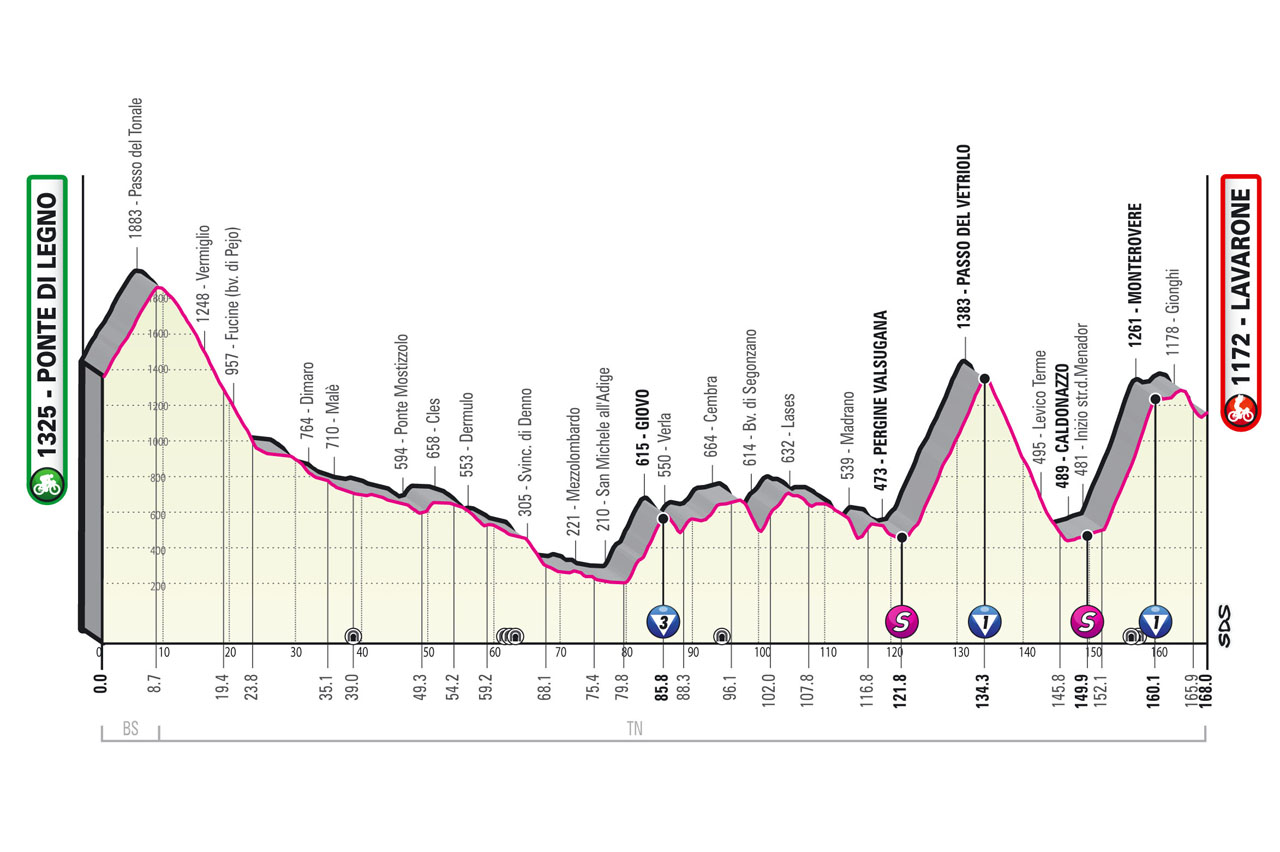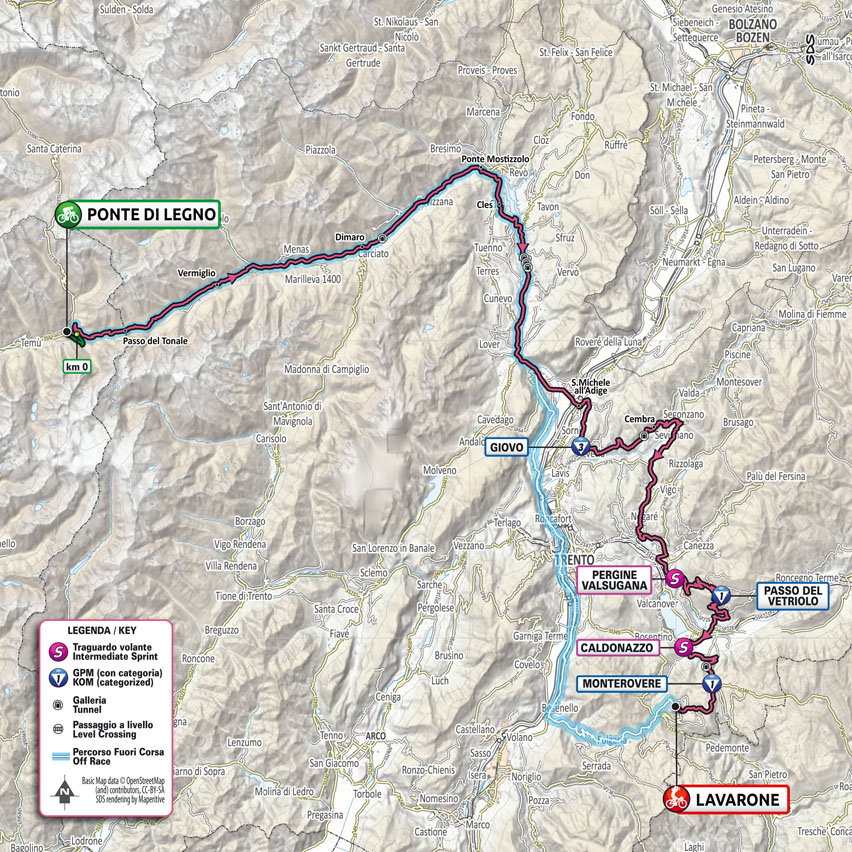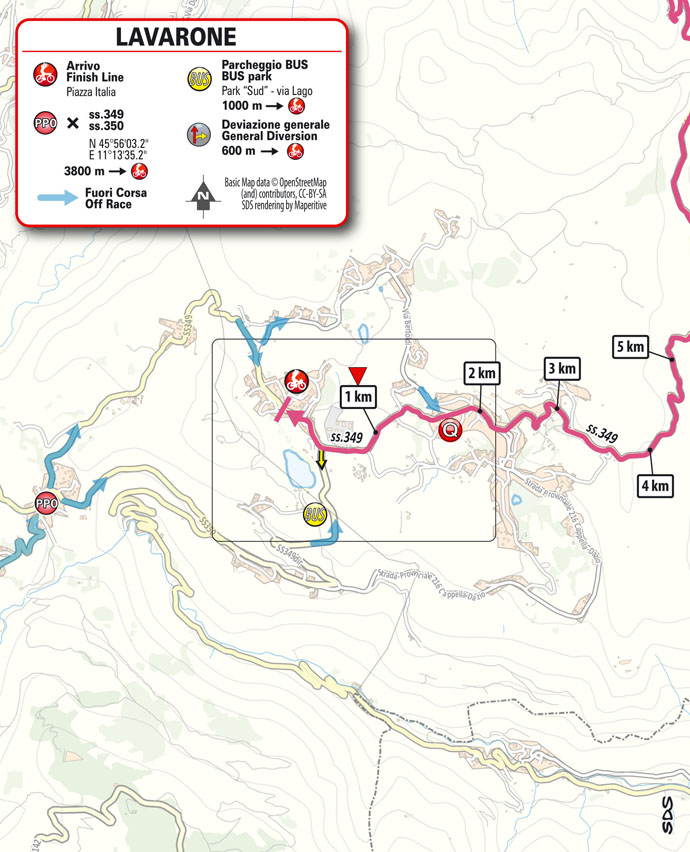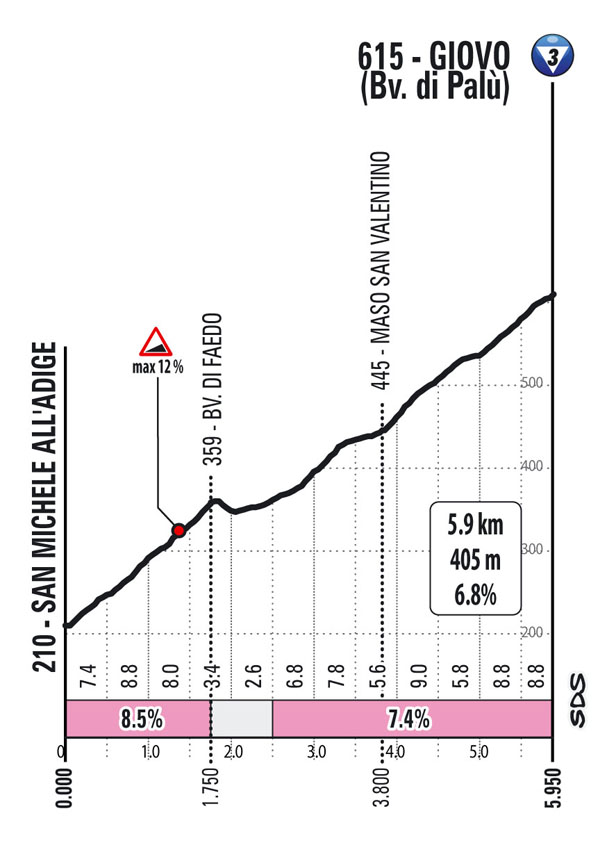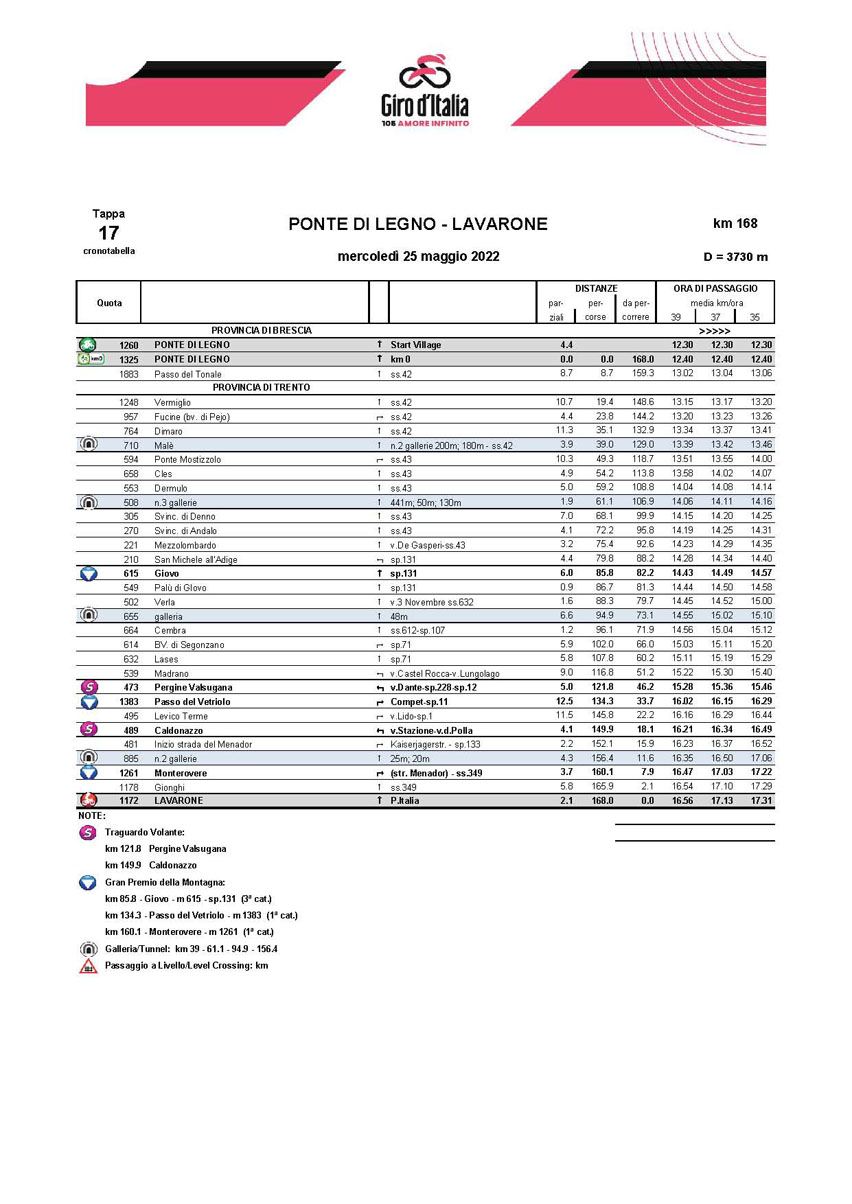profile
map
technical info
The route
This mountain stage is divided into two parts: it starts uphill, heading towards Passo del Tonale, and then continues mostly downhill for over 70 kilometres, through the Val di Sole and the Val di Non. After crossing the Adige, the route ascends to Palù di Giovo, passing through the Valle dei Mocheni and reaching Pergine Valsugana to tackle the two closing climbs. The Valico del Vetriolo is long but manageable (average 7% gradient), whilst the Menador ascent (Kaiserjägerstrasse) is narrow at points, with tunnels carved out in the rock, and gradients constantly over 10%. Past Monterovere, the finish will only be a few undulating kilometres away.
Final kilometres
After the KOM and a short descent, the route goes up again, until the -4 km marker, and then drops down once more on wide track. The final 700 metres run on a slight incline. The finish sits on tarmac.
start / finish
climb detail
final kilometres
itinerary timetable
tourist info
Host city:
Ponte di Legno
Touristic Information
Ponte di Legno is nested in the mountains that surround the area, which are majestic and extraordinary in every season. Ponte di Legno is known by many people as a winter destination – perhaps because in 1912 the Italian Touring Club defined it as “the first Italian tourist destination for winter sports”. His name is now closely connected to Passo Tonale, that links Lombardia and Trentino: 100 km of slopes in Pontedilegno-Tonale twist and turn from 1.121 mt of Temù to 3.000 mt of Presena glacier and attract many skiers from all over Europe. Parts of Stelvio National Park and Adamello National Park are located here and offer an extremely rich nature in fauna and flora.
In summertime, Ponte di Legno turns into a trekking and biking destination: Passo Gavia is a must for road bikers, bike park in Passo Tonale and gravity trails in the woods together with 500 km for MTB trails challenge the most adventurous, while the cycle path along river Oglio is suitable for families.
Gastronomy
The culinary art of a territory represents a significant element while choosing a destination, and for sure our destination Pontedilegno-Tonale has a lot to offer. The encounter of traditions between Lombardia and Trentino, where we are located, gives rise to a unique variety of flavours, which represents the essence of this area with a strong character. Authentic and fine flavours, using local products, mark the culinary proposals of the many restaurants, mountain huts and agritourism placed in the various villages.
Here there are some of the typical dishes and products:
GNOC DE LA CUA (certification of local product): it is the most famous dish in Valle Camonica, which is a type of gnocchi made of wild spinach, eggs, flour and bread soaked in milk. Then, they have to be boiled and seasoned with “sfrisida”, which is mix of sauteed onions, sage and butter and a dressed with a generous quantity of Silter and Case di Viso cheese on top.
The tail (“cua”) is given to the dough when it is taken with the spoon to be thrown into the boiling water.
CALSÙ is the name of a special kind of ravioli of Valle Camonica. The filling of these ravioli changes from village to village, in some cases the filling is made only with vegetables, in others with meat and vegetables together. The seasoning is the same for any type of Calsù: sauteed butter and sage.
SILTER is a locally produced cheese which has been awarded a certification that protects its origin since 2015. Silter is a hard fatty cheese made with Alpine Brown cows’ milk. The Consortium for the protection of Silter cheese controls all the produced cheese, piece by piece, made following a strict protocol and then marked with the writing “Silter D.O.P.” and with its symbol, which is the representation of an ancient rock engraving.
CASE DI VISO (certification of local product)
It is a cheese produced by alpine pasture cows during summertime. The dairymen use the row milk obtained from the morning milking, exclusively milked from mountain cows pasturing in Case di Viso, close to Ponte di Legno.
Beverages
Elixir Noreas has been one of the symbols of Alta Valle Camonica for a hundred years. 15 rare herbs, selected in the alpine pastures and woods of Adamello National Park, were turned into a liqueur in 1920.
The original receipt has been re-discovered by a young engineer a few years ago, who is the last descendant of the family that for a hundred years has been managing the distillery Alta Valle Camonica in Edolo. He found the notes of his great grandfather dating back to the time between the two World Wars. The precious liqueur – Elixir Noreas – is used both as a toning lotion and as a digestif and it is produced through the maceration of herbs in a solution of water and alcohol put in big wooden vats. The process lasts 15 days and then other six month of ageing follow. The herbs and spices make this liqueur particularly indicated for those who suffer from stomach aches.
The production of Elixir Noreas is very complex: only 1.020 litres are produced all at once. This is a way to maintain the high quality and the natural properties of the liqueur, which became an example of excellence of the enological production in Valle Camonica.
Other products (more than 30) are realized to satisfy all the demanding customers.
One of their liqueurs – “Genepy” – has been awarded by Slow Food with the typical “golden snail” and has been listed in a guide that presents typical products of Italian National Parks.
Main sights
PONTE DI LEGNO, with its charming elegance, has kept its mountain appeal over the years. The pedestrian area in the centre is rich in small shops and cafés: an irresistible call to its magic atmosphere in a natural environment.
PASSO TONALE is a natural amphitheater surrounded by the mountain chains of Adamello-Presanella and Ortles-Cevedale, settled on the border between Lombardia and Trentino-Alto Adige, from 1.884 m to 3.100 m of altitude.
PASSO PRESENA 3.000 Meters: you can reach it from Passo Tonale with two cable cars. On the top you can enjoy the view of Adamello glaciers and Piandineve, which is the largest glacier of the Italian Alps.
VERMIGLIO is the westernmost village of Val di Sole. It is a typical alpine village, always exposed to the sun, facing the highest peaks of the Adamello-Presanella chain. Its historical importance is proved by the numerous rests of the war, first of all the Fort Strino.
VEZZA D’OGLIO, nestled between the Val Paghera in the Adamello park and Val Grande in the Stelvio park, is rich in history and local culture: the ancient tower of the family Federici, the rests of an aristocratic building and the parish church.
VIONE, at the start of Val di Canè, is one of the most interesting villages with Medieval origin, with picturesque corners and ancient portals. Its arches and windows, wooden structures and regular-volume buildings are unique in the valley.
EDOLO is a cozy village with a fascinating historic centre, rich in granite portals, studded doors, wooden arcades, and Romanesque-style decorations. It is the end of the train line Brescia-Iseo-Edolo.
MONNO offers an unbelievable peace and is surrounded by green fields. Here the time seems to have stopped and the day life flows slowly, in direct contact with the nature. From here you can ascent Passo Mortirolo, the connection between Valle Camonica and Valtellina.
INCUDINE, settled on the shores of river Oglio, is one of the smallest villages in Valle Camonica, surrounded by pastures and conifer woods. The sanctuary of S.Vito and S.Anna at 1.877 m of altitude is not to be missed.
Lavarone
Touristic Information
What immediately strikes about Lavarone and the whole Alpe Cimbra is the landscape, pleasantly anomalous compared to the Trentino Mountain imaginary: large openings and boundless horizons, between expanses of woods, huts immersed in a panorama with Scandinavian features, and the Becco di Filadonna, the mountain emblem of the place, as a constant background. The symbols of Lavarone are: its lake, Blue Flag for years, and the Fortress of the First World War Belvedere/Gschwent, now a museum. And the Drago Vaia, a work of land art of international interest.
The small villages scattered throughout the Alpe Cimbra of Folgaria, Lavarone, Lusérn and Vigolana have been able to resist modernity, maintaining the conformation of mountain farms, keeping the secret of the ancient arts, crafts and flavours of the Cimbrian tradition, to be discovered in chic restaurants, romantic agritourism or mountain huts. Skiing and snowboarding, hiking and mountain biking, climbing and horseback riding, golfing and relaxation and then art and culture. A territory that offers many holiday ideas, good food and traditions. Alpe Cimbra is an area of exciting beauty, for its authentic nature, the traditions and people who populate it.
Gastronomy
The products of Alpe Cimbra are genuine and km 0, results of the traditions and work of the local producers. In the land of the mountain huts and the fresh milk – the white gold of Alpe Cimbra, the meat produced according to ancient dictates, honey and honeydew, vegetables grown according to old traditions, cakes and organic fruits, the secrets of the mountain relive. The farmers from Alpe Cimbra transfer their passion for the land and respect for nature to the art of cultivation. Our excellences space among different products: the Vézzena cheese, the speck from 1898, the goat cheese, the strudel, the berries and the and chestnuts of Vigolana, the honey, the leek from Nosellari and also the rainbow eggs! But the real main characters of Alpe Cimbra are the farmers. Thanks to their hard work and knowledge, they dedicate their lives to the sustainability and the safeguard of the Alpine ecosystem paying attention to mountain farming and agriculture technics. It is difficult to resist the temptations when they are genuine! Besides friendship and good company, what counts is the taste that only traditional products offer.
Beverages
Even in the glasses you can taste the authentic scent of Alpe Cimbra. From grappa to beer, from juices to fruit infusions, the authenticity of our mountain is also to drink! The numerous local productions are specialized in picking berries. The fruits are processed as in the old times to preserve the taste and quality. Our farmers employ ancient techniques to obtain natural apple and pear juices.
In addition to juices, we have other local excellences including beer, wine, grappa and rum. The Barbaforte brewery, in Folgaria, has been awarded several prizes. It produces a beer full of complex aromas by using top quality products, by carefully choosing the water, never filtering, never pasteurizing and just adding hops.
The Distilleria Bailoni (Distillery Bailoni) was established in 1953 in Altopiano della Vigolana by three brothers. Thanks to the love for their land, they take care of the growing and the harvest of prestigious grapes and produce a grappa rich in aroma and lightness. From the beginning, the Bailoni brothers have chosen natural and traditional techniques based on grape marc processing with bain-marie discontinuous method in copper alembic stills. Not only grappa is produced in Vigolana, but also sparkling wine and the Rumtopf: a liqueur prepared with rum, fruits and sugar.
Main sights
Lake Lavarone, one of the oldest lakes in the Alps, is located at 1,079 meters above sea level and has an area of 64,000 m², with a maximum depth of 17 meters. Very popular as a place for bathing and relaxation, it has been awarded the important Blue Flag for the purity of its waters for years.
Loved by Sigmund Freud – father of psychoanalysis, the walk around the lake is very suggestive, and also one of the “open routes” of Alpe Cimbra, accessible to people in wheelchairs.
The Great Sentinels of the Empire: the seven fortresses built by the Austro-Hungarians between 1908 and 1914 in view of the conflict with Italy on the territories of Folgaria (Forts Cherle, Sommo Alto and Dosso delle Somme), Lavarone (Fort Belvedere Gschwent) and Lusérn-Vezzena (Forts Cima Vezzena, Busa Verle and Lusérn). Among all, the Forte Belvedere/Gschwent in Lavarone stands out for its magnificence, built on a spur of rock overlooking the Astico Valley. Today it is a museum with exhibits and multimedia-interactive installations that give voice to the memories of the soldiers who lived and fought here. The fortresses, destinations for excursions and mountain bike tours, are included in thematic itineraries focused on the Great War.
Time seems to have stopped in Lusérn, listed among the Borghi più Belli d’Italia (Most Beautiful Villages in Italy), a small mountain village of houses leaning against each other, with sharp roofs and stone facades, defined as “the last Cimbrian island”. Its inhabitants are the last keepers of Cimbrian, an ancient language of German origin spoken by the populations from lower Bavaria, who settled in the Trentino-Veneto area between the 10th and 13th Centuries. Cimbrian language, customs and traditions are protected and valued by the Cimbrian Cultural Institute and the Lusérn Documentation Center. The Haus von Prükk house-museum is an important point of interests. The house is a typical 19th-Century Cimbrian farmhouse, faithfully restored to show visitors the rooms (the kitchen, the bedrooms, the stable) with their original features.
Base Tuono is a museum located at the Alpe di Folgaria/Coe, dedicated to the Cold War. It is one of the three missile launch sections of the former NATO Base of Passo Coe-Monte Toraro, active from 1966 to 1977. Base Tuono is the most important museum in Europe.
Guardia looks like a village out of time. Its Cimbrian name comes from the guard post that depended on the Beseno castle located nearby. However, its peculiarity is the decoration with artistic murals of exceptional value. For this reason, Guardia is known as the painted town. Life in the fields and pastures, scenes of family life, religious festivals and moments of peasant joy are among the main subjects of these works of art, generally of a naive style.
Vigolana and its plateau is a large garden behind Trento, a place where it is still possible to discover ancient villages with stone portals, balconies full of geraniums, gardens cultivated with the love and knowledge of the past. The Becco di Filadonna, 2,150 m a.s.l., is reachable from several sides. It is one of the most demanding peaks of the Vigolana group. The enchanting landscape with large meadows and woods have remained unchanged over time: a natural balcony from which to admire Alpine views, valleys and the lakes of Levico and Caldonazzo.































